|

|
|
|
11.2 Deviating chromosome number or structure
|
|
|
Origin of the deviating chromosome structure
|
|
|
|
Structural aberrations are the result of chromosomal breaks that occur during meiosis. Here deletion, duplication and isochromosome formation lead to an abnormal phenotype, while insertion, inversion as well as translocation can be balanced. This means that the carrier of this structural chromosome aberration can escape notice phenotypically, because the entire genetic material is present.
|
|
|
Reminder
|
|
The various regions of a chromosome
|
|
|
A deletion can happen in every chromosome and exhibit every size. The consequences of a deletion depends on the size of the missing segment and which genes are found on it.
A partial deletion on the short arm (p) of chromosome 5, for example, is responsible for the "cri du chat" syndrome. (4) |
|
Fig. 7 - Deletion |
|
Legend |
|

A
B
|
Normal chromosomes pair 5
Deletion 5p |
|
|
|
Fig. 7
A DNA piece has been taken out of the chromosome 5. Depending on where the piece has been removed and how long it is, this leads to the loss of several to many genes.
Animation (40 Kb)
|
|
More info
|
|
The "cri du chat" syndrome manifests itself through cat-like crying of the newborn. This disorder is accompanied by microcephaly, severe psychosomatic and mental retardation and cardiac defects.
|
|
|
|
|
|
Ends (telomeres) of chromosomes sometimes break off and are lost. In this case the formation of chromosome rings can take place in that the two ends bind to one another. If no genetic information is lost, such structural changes are balanced and the phenotype is inconspicuous. Problems only arise in gamete formation. |
|
Fig. 8 - Ring formation |
|
Legend |
|

A
B |
Normal chromosome pair
Ring formation |
|
|
|
Fig. 8
A ring can form if there has been a loss of the chromosome ends.
Animation (72 Kb)
Karyogram
|
|
A chromosome duplication is the doubling of a chromosome piece. A duplication is sometimes termed a "partial trisomy". If, therefore, a duplication is present, the person is equipped with 3 copies of the genes in the associated chromosome segment. This means that extra directions (genes) are present, leading to congenital abnormalities or developmental problems.
|
|
Fig. 9 - Duplication |
|
Legend |
|

A
B
|
normales Chromosomenpaar
Chromosom mit einer Duplication
|
|
|
|
Fig. 9
A chromosome segment is doubled and is built in again into the same chromosome.
Animation (38 Kb)
|
|
More info
|
|
The fragile X syndrome results from multiple duplications of a CGG segment (trinucleotide) in the 5' untranslated region of the FMR1 gene on the X chromosome (Xq27). Four forms of this syndrome are recognized:
- 6-40 repetitions = weak form
- 41-60 repetitions = middle form
- 61-200 repetitions = strong form
- >200 repetitions = full mutation, influencing the phenotype
Since it is an X linked mutation men are more affected than women. The fragile X syndrome leads to one of the most frequent forms of inherited mental retardation. In addition, the syndrome causes a prognathism, the face is long and small and the patient has large ears.
|
|
|
|
|
|
If chromosome pieces that have been broken out become inserted again, but reversed, an inversion has occurred.
The phenotype of this disorder is usually unobtrusive, since the entire chromosomal information is still present. When the interchanged region includes the centromere, one refers to it as a pericentric inversion, otherwise to a paracentric inversion.
|
|
|
| Fig. 10 - Paracentric inversion |
|
Fig. 11 - Pericentric inversion |
|
Legend |
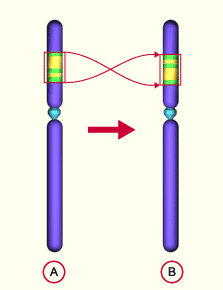
A
B
|
Normal chromosome
Chromosome with paracentric inversion |
|
|
|
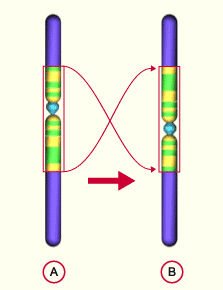
A
B |
Normal chromosome
Chromosome with pericentric inversion |
|
|
|
Fig. 10, Fig. 11
The piece that was cut out has been reinserted upside down.
Animation:
Paracentric inversion
(32 Kb)
Animation:
Pericentric inversion (64 Kb)
|
|
If chromosome pieces are reinserted somewhere else, this is referred to as an insertion. Carriers of such insertions can be phenotypically inconspicuous because no information has been lost.
|
|
Fig. 12 - Insertion |
|
Legend |
|
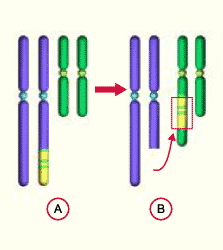
A
B
|
2 normal chromosome pairs
Insertion of a broken off piece on another chromosome |
|
|
|
Fig. 12
Insertion of a broken off piece into another chromosome.
Animation (111 Kb)
|
|
Isochromosome formation is a relatively frequent chromosomal aberration, mainly in X chromosomes. Here the chromosomes are not divided along their length (see the normal division of the chromosomes figure) but transversely. The resulting isochromosomes (karyogram) either have two short or two long arms. Persons with this X chromosome anomaly have the same phenotype as patients suffering from Turner's syndrome (45, X0). This is explained by the fact that a X chromosome arm is missing.
|
|
|
Fig. 13 - Normal division
of the chromosome |
|
Fig. 14 - Isochromosome formation |
|
Legend |
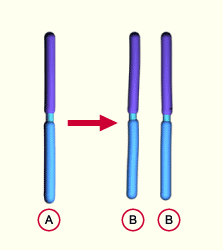
A
B |
Normal X chromosome
Identical daughter chromosomes |
|
|
|
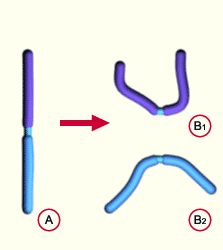
A
B1
B2
|
Normal X chromosome
Isochromosome X iso(Xp)
Isochromosome X iso(Xq) |
|
|
|
Fig. 13
A chromosome has divided in a correct way along its length. This results in two identical daughter chromosomes. This process takes place both in meiosis and also in mitosis.
Animation (109 Kb)
Fig. 14
A chromosome has divided transversely. The result is two, non- identical daughter chromosomes (X iso(Xp) and X iso(Xq)).
Animation (173 Kb)
|
|
|

